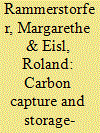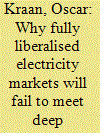|
|
|
Sort Order |
|
|
|
Items / Page
|
|
|
|
|
|
|
| Srl | Item |
| 1 |
ID:
110389


|
|
|
|
|
| Publication |
2011.
|
| Summary/Abstract |
The following article deals with real options modeling for investing into carbon capture and storage technologies. Herein, we derive two separate models. The first model incorporates a constant convenience yield and dividend for the investment project. In the second model, the convenience yield is allowed to follow a mean reverting process which seems to be more realistic, but also increases the model's complexity. Both frameworks are to be solved numerically. Therefore, we calibrate our model with respect to empirical data and provide insights into the models' sensitivity toward the chosen parameter values. We found that given the recently observable prices for carbon dioxide, an investment into C O2-storage facilities is not profitable.
|
|
|
|
|
|
|
|
|
|
|
|
|
|
|
|
| 2 |
ID:
100460


|
|
|
| 3 |
ID:
183586


|
|
|
|
|
| Summary/Abstract |
Decarbonizing the energy system by electrification of heat and transport is only effective when using low-carbon electricity sources. As many countries such as Switzerland rely on imported electricity to meet their demand, the greenhouse gas (GHG) content of electricity imports must be correctly accounted for. By assuming an average GHG content for each amount imported, impacts of electricity required in peak periods are underestimated because additional (marginal) demand is primarily met with fossil power plants. This study employs a model to capture marginal GHG contents of imported electricity from a direct and indirect (life-cycle) perspective at an hourly resolution. Implications on GHG are explored for various electricity demand and supply scenarios including electrification of heat and transport, large-scale expansion of renewables, and nuclear phase-out. We find that depending on the scenario, the average GHG intensity of consumed electricity may double, while diurnal and seasonal variations are even larger. Nonetheless, results show substantial GHG mitigation of up to 45% with electrification in case of deploying a diversified electricity generation portfolio including photovoltaics and wind. For optimal GHG mitigation, short-term flexibility as provided by hydropower is necessary to manage electricity surpluses. The main challenge, however, surrounds seasonal energy storage including sector coupling.
|
|
|
|
|
|
|
|
|
|
|
|
|
|
|
|
| 4 |
ID:
098656


|
|
|
|
|
| Publication |
2010.
|
| Summary/Abstract |
This study models the costs of electricity generation with carbon capture and sequestration (CCS), from generation at the power plant to carbon injection at the reservoir, examining the economic factors that affect technology choice and CCS costs at the individual plant level. The results suggest that natural gas and coal prices have profound impacts on the carbon price needed to induce CCS. To extend previous analyses we develop a "cost region" graph that models technology choice as a function of carbon and fuel prices. Generally, the least-cost technology at low carbon prices is pulverized coal, while intermediate carbon prices favor natural gas technologies and high carbon prices favor coal gasification with capture. However, the specific carbon prices at which these transitions occur is largely determined by the price of natural gas. For instance, the CCS-justifying carbon price ranges from $27/t CO2 at high natural gas prices to $54/t CO2 at low natural gas prices. This result has important implications for potential climate change legislation. The capital costs of the generation and CO2 capture plant are also highly important, while pipeline distance and criteria pollutant control are less significant.
|
|
|
|
|
|
|
|
|
|
|
|
|
|
|
|
| 5 |
ID:
128352


|
|
|
|
|
| Publication |
2014.
|
| Summary/Abstract |
The need for investment in capital intensive electricity networks is on the rise in many countries. A major advantage of distributed resources is their potential for deferring investments in distribution network capacity. However, utilizing the full benefits of these resources requires addressing several technical, economic and regulatory challenges. A significant barrier pertains to the lack of an efficient market mechanism that enables this concept and also is consistent with business model of distribution companies under an unbundled power sector paradigm. This paper proposes a market-oriented approach termed as "contract for deferral scheme" (CDS). The scheme outlines how an economically efficient portfolio of distributed generation, storage, demand response and energy efficiency can be integrated as network resources to reduce the need for grid capacity and defer demand driven network investments.
|
|
|
|
|
|
|
|
|
|
|
|
|
|
|
|
| 6 |
ID:
092805


|
|
|
|
|
| Publication |
2009.
|
| Summary/Abstract |
This paper presents the first comparative analysis of the relationship between natural gas storage utilization and price patterns at three major European trading points. Using two indirect tests developed by that are applied in other commodity markets, we impose the no arbitrage condition to model the efficiency of the natural gas market. The results reveal that while operators of European storage facilities realize seasonal arbitrage profits, substantial arbitrage potentials remain. We suggest that the indirect approach is well suited to provide market insights for periods with limited data. We find that overall market performance differs substantially from the competitive benchmark of the theory of storage
|
|
|
|
|
|
|
|
|
|
|
|
|
|
|
|
| 7 |
ID:
110438


|
|
|
|
|
| Publication |
2011.
|
| Summary/Abstract |
The large-scale wind power development in China has reached a bottleneck of grid integrating capability. As a result, excess wind electricity has to be rejected in the nighttime low demand hours, when the wind power is ramping up. To compensate for the fluctuation of wind power, new coal-fired power plants are being constructed along with the big wind projects in the North China grids. This study analyzed why adding coal-fired generation cannot remove the bottleneck of wind integration by modeling the operating problem of the wind integration. The peak-load adjusting factor of the regional grid is defined. Building more coal-fired power plants will not increase the adjusting factor of the current grid. Although it does help to increase the total integrated wind power in the short term, it will add difficulties to the long-term wind integration. Alternatively, the coordinated resource utilization is then suggested with the discussion of both the effective pumped hydro storage and the potential electric vehicle storage.
|
|
|
|
|
|
|
|
|
|
|
|
|
|
|
|
| 8 |
ID:
136063


|
|
|
|
|
| Summary/Abstract |
Despite of the fact that poverty is one of the major issues concerning policy makers, it has received less attention with respect to its linkages with services sector growth. In this research study, an attempt was made to quantitatively explore the nexus between growth in services sector of Pakistan and its poverty reducing impact. A time series data ranging from 1951 to 2010 were used in this study. The services sector was disaggregated into six sub-sectors. An Augmented Dickey–Fuller test was applied to check the stationarity of the data. An Auto-Regressive Distributed Lag approach to co-integration and error correction model was applied to estimate long- and short-run coefficients, respectively. The results of the study indicate that growth in wholesale and retail trade and the ownership of dwelling reduce poverty only in the short run. Growth in finance and insurance worsen poverty. The greatest impacts on poverty reduction occur as result of growth in community services (CS) and transportation, storage and communication (TSC). Among all variables, community services were found highly significant with the coefficients 0.62 and 0.308 in the long run and short run respectively. Therefore, it was concluded that relatively more stress should be given on community services such as education, and health, etc., in order to reduce poverty in Pakistan.
|
|
|
|
|
|
|
|
|
|
|
|
|
|
|
|
| 9 |
ID:
116994


|
|
|
|
|
| Publication |
2012.
|
| Summary/Abstract |
Spain exhibits a high level of energy dependence and has significant solar energy resources. These two facts have given rise to the prominence that renewable energy, particularly solar photovoltaic technology, has enjoyed in recent years, supported by a favorable regulatory framework.
Currently, the Spanish Government is providing new ways in energy policy to enhance and accelerate the development of low-power photovoltaic generation facilities for self-consumption by introducing energy policies for feed-in payments of surplus electricity.
Such facilities are an example of distributed electrical generation with important benefits for the environment and the rest of the electrical system because, when properly managed, they can help improve the system's stability and reduce overall losses.
By analyzing household demand and solar photovoltaic energy resources, the profitability of such facilities is considered in this article, taking into account the technical and economic impact of storage systems and proposing models for feed-in payments of surplus electricity, in an attempt to assess whether this method of electricity generation versus the method of conventionally supplied power from a grid at a regulated tariff can rival each other economically, in terms of parity.
|
|
|
|
|
|
|
|
|
|
|
|
|
|
|
|
| 10 |
ID:
109284


|
|
|
| 11 |
ID:
166932


|
|
|
|
|
| Summary/Abstract |
In India, 46 million, mostly rural, households lack access to electricity – over 50% of those are in the states of Bihar and Uttar Pradesh. While India has set an aggressive goal of extending the grid to all households by 2019, grid extension does not necessarily imply reliable electricity access. Indian utilities face a financial disincentive to supplying reliable electricity in rural areas because of subsidized tariffs and low consumer willingness-to-pay. Tariff subsidies for full household electrification in these states would be about Rs 15,000 Cr per year, which is two-times the existing subsidies and equivalent to 20–30% of their annual utility revenues. We find that super-efficient lamps, TVs, and fans can reduce the energy consumption of a rural household by over 70% cost-effectively, resulting in a net reduction in the total subsidy burden. Reduced consumption offers an opportunity to raise consumer tariffs while ensuring consumers’ monthly electricity bills reduced. We also argue that super-efficient appliances make consumer-side storage cost-effective, leading to greater consumer willingness-to-pay. We recommend adoption of super-efficient appliances as part of the electricity access initiative in India, and electricity service based tariff setting as the next policy steps towards providing a reliable and sustainable electricity access.
|
|
|
|
|
|
|
|
|
|
|
|
|
|
|
|
| 12 |
ID:
177435


|
|
|
|
|
| Summary/Abstract |
Developing countries are facing electrical energy shortage problems. These nations are adopting load shedding to protect their national grids from instabilities. In this research, load shedding is analyzed where customers opt for the use of uninterrupted power supplies (UPS) and store energy in batteries. It is found that Pakistan has wasted 7117 GWh of energy by charging and discharging the batteries of UPS by 26, 201, 910 residential and commercial customers of the country in 2018. The energy deficit of Pakistan can be reduced from 8.7% to just 1.5% by removing all UPS from the national grid. Several renewable alternatives such as photovoltaic (PV) systems, concentrated solar power plants, pump-hydro on dams, floating PV systems, wind turbines, and PV energy import from the Middle East have been suggested. Analytic hierarchy process is used for the selection of best city and best lake for PV and floating PV system respectively based on multivariable criteria. Pakistan overcame the gap between the electrical load demand and capability in 2019. A reduction of 77% in load shedding in Pakistan resulted in a dipping of load peak of 26 GW in 2018 to 25 GW in 2019. This drop-in load in 2019 is a direct result of the removal of 77% of UPS from the national grid. India, Sri Lanka, Nepal, and other developing countries can use this analysis to enhance their power systems.
|
|
|
|
|
|
|
|
|
|
|
|
|
|
|
|
| 13 |
ID:
149961


|
|
|
|
|
| Summary/Abstract |
This study presents a framework to quantitatively evaluate decentralized generation and storage technology (DGST) performance and policy impacts in a rural setting. The role of DGSTs in the future energy systems planning of a rural agglomeration in Switzerland is examined using a cost optimization modeling approach. Heat and electricity demand for major sectors are considered. Scenarios introduce DGSTs in a stepwise manner to measure incremental impacts on future capacity planning compared to a baseline scenario. Sub-scenarios also examine the impacts of carbon mitigation policies, and a sensitivity analysis is carried out for key energy carriers and conversion technologies. DGSTs enable a significant reduction in electricity grid usage for the community considered. Small hydro with a storage reservoir and photovoltaics enable the community to become largely self-sufficient with over 80% reductions in grid imports by 2050 compared to the baseline scenario. Storage enables maximum usage of the available hydro potential which also leads to network upgrade deferrals and a significant increase in photovoltaic installations. Investment decisions in small hydro are robust against cost variations, while heating technology investment decisions are sensitive to oil and grid electricity prices. Carbon pricing policies are found to be effective in mitigating local fossil fuel emissions.
|
|
|
|
|
|
|
|
|
|
|
|
|
|
|
|
| 14 |
ID:
116983


|
|
|
|
|
| Publication |
2012.
|
| Summary/Abstract |
Through a parametric time-series analysis of 8 years of hourly data, we quantify the storage size and balancing energy needs for highly and fully renewable European power systems for different levels and mixes of wind and solar energy. By applying a dispatch strategy that minimizes the balancing energy needs for a given storage size, the interplay between storage and balancing is quantified, providing a hard upper limit on their synergy. An efficient but relatively small storage reduces balancing energy needs significantly due to its influence on intra-day mismatches. Furthermore, we show that combined with a low-efficiency hydrogen storage and a level of balancing equal to what is today provided by storage lakes, it is sufficient to meet the European electricity demand in a fully renewable power system where the average power generation from combined wind and solar exceeds the demand by only a few percent.
|
|
|
|
|
|
|
|
|
|
|
|
|
|
|
|
| 15 |
ID:
105733


|
|
|
|
|
| Publication |
2011.
|
| Summary/Abstract |
Carbon Capture and Storage (CCS) is the critical enabling technology that would reduce CO2 emissions significantly while also allowing fossil fuels to meet the world's pressing energy needs. The International Energy Agency analysis shows that although the developed world must lead the CCS effort in the next decade, there is an urgent need to spread CCS to the developing world. Given technologies for reducing GHG emissions originate mainly in developed countries, technology transfer, as an important feature emphasized by both the United Nations Framework Convention on Climate Change (UNFCCC) and the Kyoto Protocol, therefore has a key role to play in bridging a gap between developed and developing countries. The main objective of this paper is to explore potential policies and schemes promoting the transfer of CCS technologies to developing countries. First, it reviews the global CCS status, analyzes the significant gap of CCS in developed and developing countries, and investigates stakeholder perceptions of diffusing CCS to China, which is a major developing country and a significant potential candidate for large-scale CCS deployment; then the authors make an attempt to understand technology transfer including its benefits, barriers, and definition. The UNFCCC explicitly commits the developed (Annex I) countries to provide financial and technical support to developing countries under favorable terms. The authors argue that the ultimate goal of technology transfer should not only be limited to apply CCS in developing countries, but also to enhance their endogenous capabilities, which will enable future innovation and ensure long-term adoption of low-carbon technologies. As a result, the authors propose a four-pronged approach to the transfer of CCS technologies, which involves physical transfer of explicit technologies, a financial mechanism, endogenous capacity building, and a monitoring mechanism. Concrete enhanced actions to promote CCS technology transfer are also proposed. The four-pronged approach and related enhanced actions proposed in this paper are also applicable to other low-carbon technology transfer.
|
|
|
|
|
|
|
|
|
|
|
|
|
|
|
|
| 16 |
ID:
166705


|
|
|
|
|
| Summary/Abstract |
Full decarbonisation of the electricity system is one of the key elements to limit global warming. As this transition takes place, the electricity system must maintain system adequacy and remain affordable to consumers. In liberalised electricity markets investors are seen as key actors driving this transition.
|
|
|
|
|
|
|
|
|
|
|
|
|
|
|
|
|
|
|
|
|